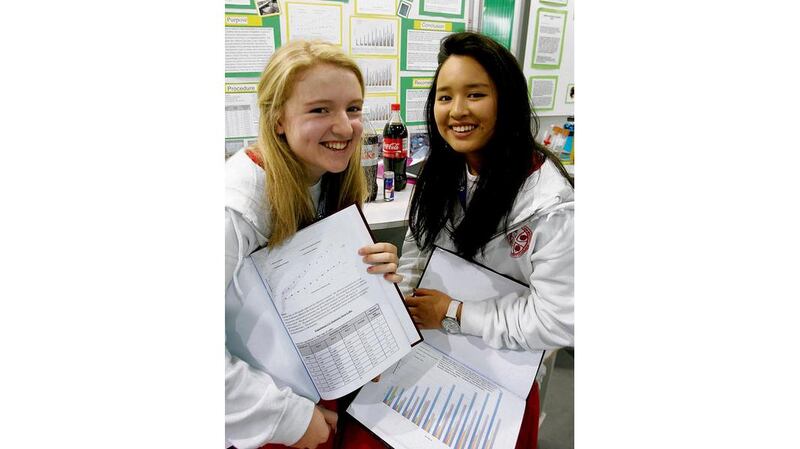As the annual exhibition draws to a close, its participants once more prove to be a creative force for the future
TWO PROJECTS each from the North and South have claimed the four top prizes in this year’s BT Young Scientist and Technology Exhibition under way at the RDS in Dublin. They include student participants from counties Cork, Down, Derry and from Dublin.
The winners were announced last night at a special awards ceremony at the RDS. Minister of State for Science Conor Lenihan who officiated at the event said its importance was in helping students experience “the sense of fun and excitement” involved in science and research.


The event also encouraged more students into the sciences. “We need a strong number of them coming forward with science qualifications and moving into research and into industry,” Mr Lenihan said.
Paul McKeever (14) and Bryan Murphy (15), two fourth-year students from Abbey Christian Brothers School in Newry, Co Down, won the best group prize for their project to design and build an innovative detection system to ensure those using dangerous machinery are wearing safety glasses.
They decided to enter their project after an accident at school. “We were in class and constantly being told to put on our glasses but one student still got a bit of plastic in his eye and had to go to hospital,” Bryan explained.
They researched a range of detection systems, looking at infrared and radio signals before finally settling on ultrasound. They built a transmitter plus electronics and batteries into ordinary safety glasses and wired matching ultrasound receivers into two examples of machinery including a drill press and jig saw.
They were able to demonstrate how their designs performed at the exhibition using machinery on their stand. They showed that if the special glasses are not worn the equipment will not work, and if a worker looks away from the machine, putting themselves at risk, the machine instantly stops.
Both students said they really enjoyed science, but Paul wants to become a doctor when he moves on to third level. Bryan said he wanted to stay with science and technology when he leaves school. They receive a BT trophy and €2,400.
Hannah Eastwood (18), a final-year student at Loreto College, Coleraine, Co Derry, took the runner-up individual prize worth €1,200 with a study of “green rust”, a mineral known as lepidocrocite. Green rust can lift all kinds of heavy metals from drinking water, but the mineral is notoriously difficult to make, Hannah explained.
Existing green rust producing methods take up to seven hours in the lab and, if the acidity of the solution is not kept perfectly balanced, other minerals will be formed such as goethite. This makes the green rust less effective and reduces its value.
Hannah devised a new “lab-friendly” way to make the mineral that overcomes the biggest problem, trying to keep the solution acidity balanced at pH 7. A sensor monitors the solution and a small pump adds a chemical if it gets too acidic. The system can be automated and does not require specialised or costly lab equipment. She also used chromium to show how lepidocrocite can take this heavy metal out of water. She used chromium because it produced a yellow colour that was easily seen by those visiting her stand, but it would work for any heavy metal, she stressed. “It is not just for chromium, it is all heavy metals.”
She also said her method uses cheap materials that readily trap expensive chromium. It was worth $7,000 (€4,870) per tonne and the chromium can readily be extracted and reused, she added. She hopes to study veterinary medicine when she leaves school.
The runner-up group prize worth €1,200 went to Leona Chow and Mollieanne Gallagher, both 16 and transition-year students from Alexandra College, Dublin. They studied how caffeine can interfere with key digestion enzyme pepsin, something that is seen in chronic atrophic gastritis (CAG), a stomach condition which in turn is sometimes a precursor to cancer.
Their interest was sparked when one of their relatives developed stomach cancer. “We wanted to test if caffeine could be the cause for this,” said Leona. They conducted a number of in-vitro tests using a variety of caffeine sources including cola drinks, caffeine-based energy drinks and caffeine in coffee.
They used egg whites as the protein and added caffeine and pepsin, the enzyme that breaks down proteins in the stomach, and also hydrochloric acid, which provides the acidity in our own stomachs. They were able to show that the presence of caffeine did indeed interfere with the pepsin, preventing proper breakdown of protein, something that is seen in people with CAG.
They now hope to bring their project forward and develop it further for next year’s Young Scientist competition. Mollieanne is unsure what she will study yet but greatly enjoyed the research involved in their project.
The 2010 BT Young Scientist and Technology Exhibition remains open all day today, drawing to a close this evening. Family tickets cost €25, adults are €12 and student/concessions are €6










